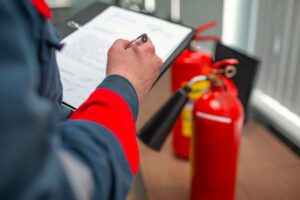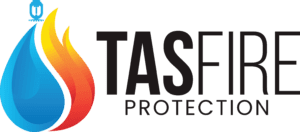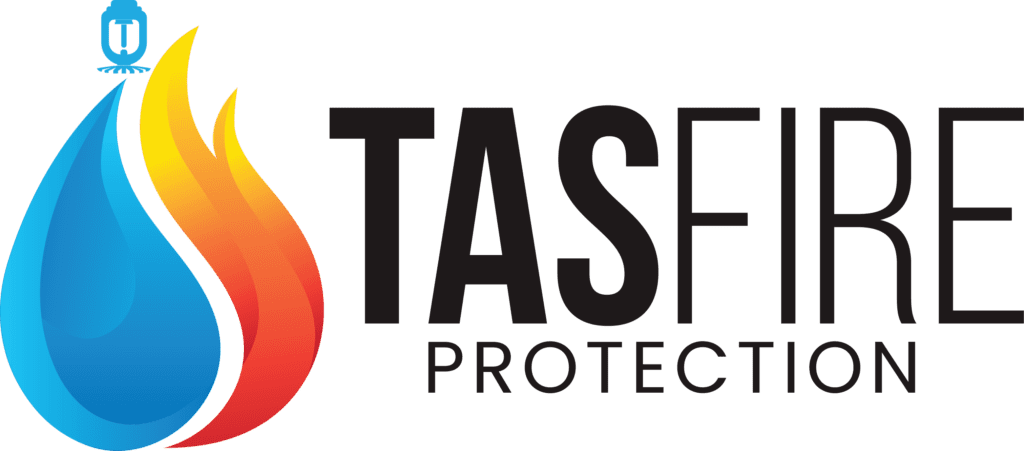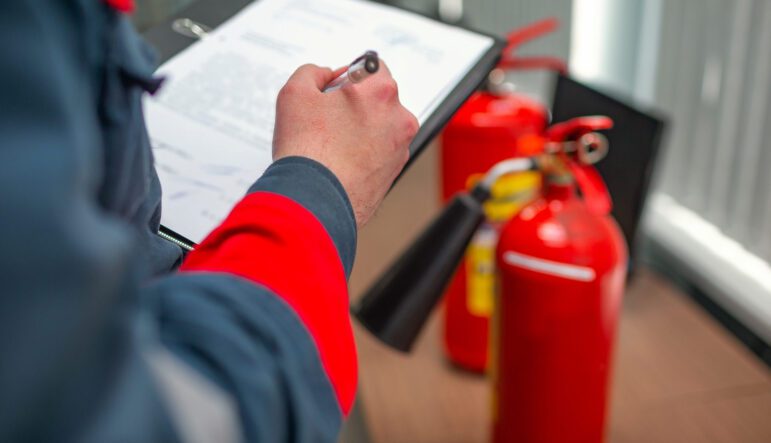The Importance of Fire Protection Services: Ensuring Safety and Preparedness…
 Fire protection services play a critical role in safeguarding lives, property, and businesses from the devastating effects of fires. These services encompass a range of systems and measures designed to detect, suppress, and mitigate the impact of fires. While the specific requirements for fire protection may vary depending on local regulations and building codes, one thing remains constant: the need for regular maintenance and inspection to ensure the effectiveness and reliability of these systems. In this comprehensive guide, we will explore the importance of fire protection services, the different types of fire protection systems, and the recommended maintenance and inspection schedules.
Fire protection services play a critical role in safeguarding lives, property, and businesses from the devastating effects of fires. These services encompass a range of systems and measures designed to detect, suppress, and mitigate the impact of fires. While the specific requirements for fire protection may vary depending on local regulations and building codes, one thing remains constant: the need for regular maintenance and inspection to ensure the effectiveness and reliability of these systems. In this comprehensive guide, we will explore the importance of fire protection services, the different types of fire protection systems, and the recommended maintenance and inspection schedules.
Ensuring Safety: Protecting Lives and Property
The primary objective of fire protection services is to ensure the safety of individuals and the preservation of property. By implementing robust fire protection systems, businesses and homeowners can significantly reduce the risks associated with fires. These systems act as early warning mechanisms, detecting the presence of smoke, heat, or flames and triggering alarms to alert occupants and authorities. In addition to providing early detection, fire protection services encompass various suppression systems, such as fire sprinklers and fire extinguishers, which are designed to control and extinguish fires before they can escalate.
Understanding Fire Protection Systems
Fire protection systems encompass a range of technologies and measures that work together to detect, suppress, and mitigate fires. These systems can be categorized into different types, each serving a specific purpose in fire prevention and response. Here are some of the key fire protection systems commonly employed:
Fire Alarms and Detection Systems
Fire alarms and detection systems are the first line of defense in fire protection. These systems employ various sensors, such as smoke detectors and heat sensors, to detect the presence of fire. Once a fire is detected, the alarms are activated, alerting occupants to evacuate the building and prompting the necessary response from emergency services.
Fire Sprinkler Systems
Fire sprinkler systems are designed to rapidly suppress and control fires by releasing water or other extinguishing agents. These systems consist of a network of pipes and sprinkler heads strategically installed throughout a building. When heat from a fire activates a sprinkler head, it opens, allowing water to flow onto the fire and suppress it. Regular maintenance and inspection of fire sprinkler systems are essential to ensure their proper functioning and prevent any potential failures.
Fire Extinguishers
Fire extinguishers are portable devices that can be used to suppress small fires. They contain extinguishing agents, such as water, foam, or dry chemicals, which can be discharged onto a fire to extinguish it. Fire extinguishers should be readily accessible in all areas of a building, and regular inspections and servicing are necessary to ensure they are fully functional and ready for use in an emergency.
Fire Suppression Systems
Fire suppression systems employ specialized agents, such as clean agents, carbon dioxide (CO2), or wet chemicals, to suppress and extinguish fires in specific environments or situations. These systems are commonly used in areas where water-based suppression may not be suitable, such as data centers, laboratories, or facilities housing sensitive equipment. Regular inspections and maintenance are vital to ensure the effectiveness of these systems.
Importance of Regular Maintenance and Inspection
While the installation of fire protection systems is a crucial first step, their ongoing maintenance and regular inspections are equally essential. These measures are necessary to ensure that the systems are in optimal working condition and ready to respond effectively in the event of a fire. Regular maintenance and inspections offer several key benefits:
System Reliability and Effectiveness
Regular maintenance and inspections help ensure that fire protection systems, such as fire alarms, sprinklers, and extinguishers, are functioning correctly. Any potential issues or deficiencies can be identified and addressed promptly, enhancing the reliability and effectiveness of these systems. This proactive approach minimizes the risk of system failures during an actual fire emergency.
Compliance with Regulations and Codes
Local regulations and building codes often mandate the installation and maintenance of fire protection systems. Regular inspections and maintenance help ensure compliance with these requirements, preventing potential legal issues and penalties. Fire protection service providers are well-versed in the relevant regulations and can assist building owners in meeting the necessary compliance standards.
Early Detection and Response
Effective fire protection systems rely on early detection and prompt response. Regular inspections and maintenance help identify any potential issues that may hinder the systems’ ability to detect fires accurately. By addressing these issues promptly, building owners can ensure that their fire protection systems remain responsive and capable of triggering timely alarms and initiating appropriate suppression measures.
Minimizing Property Damage
Timely detection and suppression of fires significantly reduce property damage. Well-maintained fire protection systems can quickly control and extinguish fires, limiting their spread and minimizing the extent of damage to a building and its contents. This can lead to substantial cost savings in terms of repairs and replacements, as well as preventing potential business interruptions.
Ensuring Occupant Safety
Occupant safety is paramount in any building. Regular inspections and maintenance of fire protection systems help ensure that occupants are adequately protected in the event of a fire. Functional fire alarms, properly functioning sprinkler systems, and accessible fire extinguishers provide occupants with the means to respond effectively and evacuate safely.
Recommended Maintenance and Inspection Schedules
To maintain the reliability and effectiveness of fire protection systems, it is essential to adhere to recommended maintenance and inspection schedules. While these schedules may vary depending on local regulations and specific system requirements, here are some general guidelines:
Fire Alarms and Detection Systems
Fire alarms and detection systems should undergo annual inspections by qualified professionals. These inspections involve testing the alarms, sensors, and control panels to ensure their proper functioning. Regular checks, such as weekly visual inspections, should also be conducted by building occupants or designated personnel to ensure that the alarms are free from obstructions and visually intact.
Fire Sprinkler Systems
Fire sprinkler systems should undergo quarterly and annual inspections. These inspections involve checking the sprinkler heads, control valves, and alarm devices, as well as conducting flow tests to verify water supply adequacy. Additionally, in colder climates, measures should be taken to prevent freezing of the sprinkler system during winter months.
Fire Extinguishers
Fire extinguishers should be inspected on a monthly basis by building occupants or designated personnel. These inspections involve checking the extinguisher’s pressure, ensuring it is free from damage or blockages, and verifying that the tamper seal is intact. A more detailed examination and servicing should be conducted annually by a certified fire protection service provider.
Fire Suppression Systems
Fire suppression systems, such as clean agent systems or CO2 systems, must undergo semi-annual inspections in accordance with NFPA guidelines. These inspections involve checking the system components, verifying gas cylinder pressures, and conducting functional tests. Wet chemical suppression systems may require more frequent inspections due to their specific application and maintenance requirements.
It is important to note that these maintenance and inspection schedules serve as general guidelines. Local regulations and building codes may impose more stringent requirements or specify additional measures, necessitating the involvement of certified fire protection service providers to ensure compliance.
Fire protection services are crucial for creating a safe environment in any building. By implementing and maintaining effective fire protection systems, building owners can significantly reduce the risks associated with fires and protect lives and property. Regular maintenance and inspections are essential to ensure the reliability and effectiveness of these systems. By adhering to recommended schedules and working with certified fire protection service providers, building owners can ensure that their fire protection systems remain in optimal working condition, ready to respond effectively in the event of a fire. Prioritizing fire protection services is a proactive step towards ensuring safety and preparedness in any building, providing peace of mind to occupants and stakeholders alike.
Contact Us (905-870-7779) for a Free Consultation!
—

About TAS Fire Protection
TAS Fire Protection offers comprehensive and cutting-edge fire, security, and electrical services to clients with residential, commercial, industrial, or high-rise properties. Our team of highly skilled professionals has years of experience in installing, maintaining, and inspecting fire, security, and electrical systems and equipment.
> Learn More

